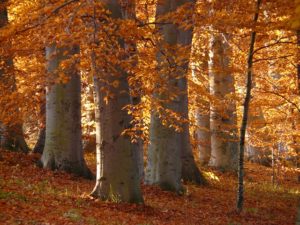One of the most enduring misconceptions about hardwood is that it is unsustainable as a building material. Nothing could be further from the truth. Hardwood is the very definition of a renewable resource. It grows abundantly, and quicker than you might expect. You can recycle it endlessly. So long as it’s harvested responsibly, hardwood is as sustainable as can be. Today, we’d like to highlight a few sustainable hardwood species that are especially abundant in and native to our mid-Atlantic region.

Here are a few of the most abundant and sustainable hardwood species in the mid-Atlantic region.
Juglans nigra — Black Walnut
You’ve probably come upon black walnuts before whether you recognized it or not. Every fall, their large green fruits litter the mid-Atlantic roadsides. The fruits are sometimes as large as a tennis ball, and enclose a nut the size of your regular English walnut. Few projectiles fit more snugly in the hands of rambunctious schoolchildren.
The black walnut is highly regarded both as a food source and as a hardwood. It is exceptionally resistant to decay, and holds paint and stains like few other hardwoods. Given its remarkable qualities as a building material, it can cost a pretty penny. You will find it all over—doors, furniture, and joinery.
Liriodendron tulipifera – Tulip Tree
The tulip tree is among our most sustainable hardwood species not just because of its abundance, but because of how fast it grows. It and eastern cottonwood are probably our two fastest-growing hardwood species, only the latter is quite uncommon in the mid-Atlantic.
The tulip tree goes by a couple of different names, such as ‘tulip poplar’ or ‘yellow poplar.’ We’ll just call it ‘tulip tree,’ though, because it is not technically a poplar.
You can recognize tulip tree both by its unique leaf shape—nothing else looks like it—and its remarkably straight trunk. Here are a few of its most common uses:
- Cabinets
- Molding
- Doors
Quercus alba — White Oak
Few tree species command more respect than the oaks. We can break the majority of oaks into one of two groups: red or white. Today, we’d like to focus on the latter. This isn’t because it’s a more sustainable hardwood species, but because it happens to be the state tree of Maryland!
How do you separate a white oak apart from a member of the red oak group? It’s easier than you might expect. The easiest way is to take a look at a leaf. If it’s a white oak, the lobes will be round, rather than coming to a point. Its bark isn’t quite white, but it may appear an ashy gray.
White oak is an enduring classic for molding and millwork. It even has more specialized uses such as tool handles or barrels for wine and whiskey.
INTERESTED IN LEARNING MORE ABOUT US? MAHOGANY INC. IS HERE TO ANSWER YOUR QUESTIONS AND INQUIRIES
Whenever you’re ready to build or renovate a business, Mahogany Inc. has your back. Call us at 410-727-0334 with any questions and speak to one of our licensed professionals. To see examples of our work or to gain inspiration for your next project, follow us on Facebook, Twitter, and Pinterest.
